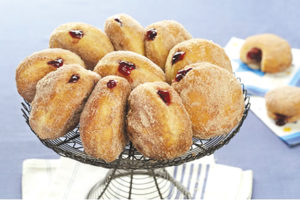 This eight-day, wintertime “festival of lights,” celebration includes a nightly menorah lighting, special prayers and fried foods.
This eight-day, wintertime “festival of lights,” celebration includes a nightly menorah lighting, special prayers and fried foods. The Hebrew word Chanukah means “dedication,” and is thus named because it celebrates the rededication of the Holy Temple. Also spelled Hanukkah (or variations of that spelling), the Hebrew word is actually pronounced with a guttural, “kh” sound, kha-nu-kah, not tcha-new-kah.
The foods of the season are so enticing. Cook (and fry) up a traditional Chanukah storm: latkes to applesauce, jelly doughnuts and more recipes for all tastes.
A typical Chanukah menu sounds as though it were planned by the under-12 crowd: potato pancakes, fried, of course, in lots of oil; sweet cream-cheese rugelach; strawberry jam–filled doughnuts (sufganiyot) covered in powdered sugar; fried apple fritters; cheese-filled doughnuts fried in oil and dipped in honey; cheese blintzes; etc.
 Is it all just a ploy to keep kids lingering around the candles and enjoying a family meal? Not at all!
Is it all just a ploy to keep kids lingering around the candles and enjoying a family meal? Not at all! Chanukah food traditions have their origins in the first years that the holiday was celebrated and are meant to remind people of certain miracles associated with the events of Chan-ukah itself. And, of course, remembering the miracles and the freedom that they are all celebrating adds a special flavor to everything they serve.
Every culinary culture has a doughy pastry fried in oil, a local version of the doughnut. Jews are no exception. Wherever Jews have lived throughout history, they’ve made a tradition of creating a special Chanukah version of fried dough to celebrate the Miracle of Oil.
Ashkenazi Jews emigrating from Germany brought the Sufganiyot tradition to Israel in the 1930s. Who can resist these fluffy pillows of dough (pictured here) with your favorite jam filling? These always fly off the table. Make sure to get one before they’re gone!















Follow Us